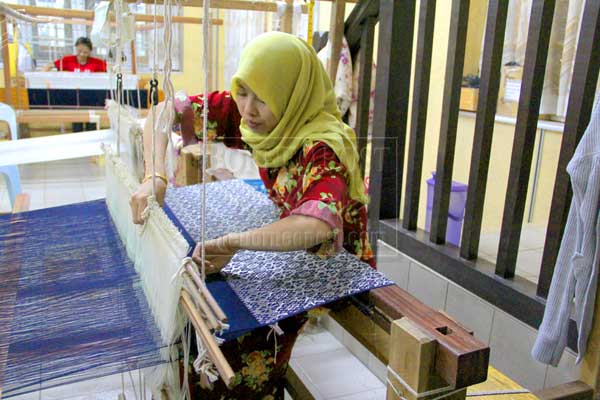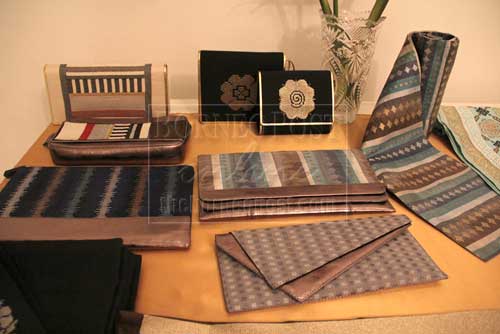WITH its elaborate motifs and delicate weaves, one does not have to be a connoisseur of the arts to appreciate the hours of intense labour and careful attention that go into crafting each piece of handwoven songket.

SKILLED: Here, a weaver makes sure everything is in order before continuing her work. Every flaw, no matter how small, must be unravelled and rewoven. Tanoti weavers are well-equipped with a thorough understanding of every stage of the pre-weaving and weaving process as a result of their hands-on training.
Historically, the textile of choice of Malay elite and royalty, songket was often handed down from father to son, mother to daughter as prized family heirlooms to be treasured and worn only for the most special of occasions.
Little wonder, songket continues to enjoy an esteemed place in the public eye today as it has done for centuries before.
However, the reason why it is so highly valued today is that weaving songket by hand is no longer as widely practised as it used to be.
Not many are willing to take up the difficult and time-consuming craft. Older generations of weavers passed away, leaving a progressively shrinking pool of younger weavers to carry on the tradition. The introduction of mechanisation and cheaper pretenders has only accelerated the craft’s decline.
Thankfully, within the whitewashed walls of an unassuming building in Kuching, the future of songket in Sarawak shines bright.
Near tragedy
The building is called Tanoti House — headquarters for Tanoti Sdn Bhd, the company from which the house takes its name. However, Tanoti almost did not exist, recalled director Jacqueline Fong to thesundaypost.
Last year, the Terengganu-based Tuanku Nur Zahirah Foundation or Yayasan Tuanku Nur Zahirah (YTNZ), whose main aim is to promote traditional songket throughout Malaysia, decided to pull down the shutters on its Kuching centre to better concentrate on its homestate operations – bringing four short but encouraging years of investment and efforts to nurture local weavers to a close.
The future of the young women trained by the foundation hung in uncertainty for months as viable solutions were sought to keep the momentum behind Sarawak’s nascent songket revival going.
At the eleventh hour, Fong and her associates stepped in, providing a much-needed and welcomed lifeline.
As a result, Tanoti was established on May 1, 2012, to house a community of artisans, dedicated to practise the ancient craft of songket weaving.
Today, the company is not only helping to shape the future of one of Malaysia’s most revered handicrafts but also strategically position the local industry for sustainable growth through modern research and design, marketing and sound human resource management practices.
Proudly Sarawakian
The name Tanoti is derived from the Sanskrit word for weave. But make no mistake, Tanoti has a strong Sarawakian identity. It is 100 per cent owned and managed by Sarawakians. Its 16 weavers – 10 skilled and semi-skilled weavers and six trainees – are also Sarawakian.
Despite being only in business officially since May, current demand for Tanoti’s products is more than the company can cope with — thanks to fervent word of mouth.
Part of the reason is the uncompromising quality control and standards of quality which govern the whole weaving process.
“You cannot cheat on quality when it comes to songket,” said Fong as she showed thesundaypost the exquisite pieces that the weavers recently completed.
“Even a tiny flaw will be obvious for all to see.”

CONTEMPORARY: Tanoti’s in-house research and design team is now developing a line of songket inspired fashion accessories, including scarves, wraps, and clutches.
The final product must be perfect in weave quality and presentation. Even the most minor imperfection is required to be unravelled and rewoven – it is a non-negotiable component of the job.
Tanoti weavers are trained in two types of weaving techniques – Peninsula songket and Sarawak songket.
While both can result in beautiful, luxurious textiles in the hands of a skilled weaver, there are key differences between the two.
“Sarawak songket is very irregular, very technically difficult and very demanding as it uses continuous technique,” Fong explained.
“In Sarawak songket, you will never see the lines parallel, and depending on the design, the front and reverse side of the fabric will look almost similar.
“For Peninsula, the difference between the front and reverse side is apparent. Also, Sarawak songket is thicker and there is an embossed 3D-like feel to the touch.”
Generally, Peninsula songket is relatively easier, faster and cheaper to weave compared to Sarawak songket, which has its roots in the Brunei Sultanate.
However, the overall cost and time required to craft each piece also depended on design, materials and what the client wanted, Fong pointed out.
Detailed craftsmanship
Tanoti does not shy away from shining the spotlight on their weavers upon whose efforts a large part of the quality of the final product rests on.
For Fong, there is no question Tanoti weavers stand among the best in Malaysia. Her confidence is not plucked from thin air.
The company is serious about not only wanting Tanoti weavers to understand the production process from beginning to end, they also want them to be more than capable upholding the strict standards of quality, expected of Tanoti products.
Moreover, the weavers are expected to teach their younger counterparts to do the same.
Most of their weavers are young women from villages around Kuching, mostly from Asajaya in Kota Samarahan, Gedong and Serian. They are aged between 20 and 32 years and of varying skill levels.
Many of them started learning to weave without any prior knowledge of weaving, which suits Tanoti just fine as the company finds it easier to teach from scratch.
In fact, many of their current weavers had no prior experience of songket weaving before their training under the YTNZ.
Cooperation and teamwork are built on close relationships between the weavers as the company relies on in-house training built on a mentor-mentee concept.
Highly-skilled senior weavers are expected to train and supervise the less-experienced weavers and trainees in addition to completing their respective assignments.
All trainees undergo hands-on training from the start, beginning with the multiple processes of pre-weaving where often more than one pair of hands are required. Trainees learn to cooperate with each other in getting to grips with the ins and outs of weaving songket.
The eventual goal is to be able to weave independently at their own loom – a standard which could take anywhere between six months to over a year, depending on the individual weaver’s ability to pick up the necessary skills and techniques.
Business sense
Fong pointed out that running a profit-oriented business does not have to come at the expense of protecting the welfare of its weavers as well as neglecting its social responsibility towards preserving the craft.
It all adds towards strengthening the long-term sustainability of the local industry.
“Investing in our employees’ welfare and training makes good business sense because it ensures high standards of input, skilled labour, materials and quality are maintained.
“We don’t want them to be just weavers, we want them to be artisans,” she said, explaining Tanoti’s proactive stand towards developing their weavers’ capabilities and furnishing them with knowledge and skills for a viable, long-term job and career.
“All our weavers are paid a monthly salary together with EPF and SOCSO. Eventually, if they decide to move away from the centre to work from home or elsewhere as independent contract weavers, we are also open to the idea – as long as what they produce meets our standards of quality,” she added.
As it is, Tanoti is now in the market to recruit and train more weavers to cope with booming customer demand.
Diversified lines
While Tanoti’s weaving methods tend to follow the traditional, a decidedly contemporary business-minded approach is applied to the rest of the business’ operations and marketing.
Their research and design (R&D) team looks into technical aspects such as which types of dyes and materials are suitable for which types of products.
For example, songket, used for interior design purposes, tend to be created, using heavier and hardier materials such as for curtains and cushion covers. For songket which is worn on the body, the songket is constructed of softer, finer material which feels comfortable to the touch.
The team is also now developing a line of fashion wear and accessories which incorporate songket textiles and designs, including scarves, wraps and clutches.
“We conduct our own R&D so that we know what combination of weaving styles, colours, dyes and materials works best to create different designs and products.
“Songket is a premium product because it is hand-made. But by diversifying into other product lines, we can make it accessible and affordable to more consumers and blossoming art collectors who may not be able to afford owning a larger piece just yet,” Fong said, adding they are looking into collaborating with local businesses to produce some of their products.
Besides the catwalk, Fong believes there is a sizeable market for songket in high-end interior design as well as amongst corporate and private art collectors, in Malaysia as well as overseas.
For commissioned art pieces, Tanoti weavers usually use Sarawak songket technique because of the advantages of its reverse side properties as well as added durability.
“Some clients want traditional designs and motifs. Others have a preconceived theme in mind which our R&D team works closely with clients to bring their vision to reality.
“We also have had clients who asked us to use traditional techniques to weave their self-created art designs,” Fong shared.
Given the sensitive issues of intellectual property rights behind the designs and techniques used in some of the commissioned art pieces, Tanoti is understandably tight-lipped about naming their clients as well as disclosing prices paid.
Suffice to say, it is not uncommon for the price of a large, customised songket piece to run into thousands, if not tens of thousands, of ringgit.
“It really depends on the design and size of the final product. If it is a complex and large piece, a skilled weaver may take one full day just to weave two centimetres of songket,” said Fong.
“When you consider these aspects and the fact that there is practically no room for error in the final product, pricing does not really become an issue.”
(Next week: Part two – A peek behind the scenes of what goes into creating each piece of songket).

